Staying Healthy While Flying
Whether you are traveling for business or pleasure, flying can be a bit stressful. Getting sick while traveling can really put a damper on your trip. To reduce the risk of exposure to germs and increase your chances of staying healthy when traveling by air, keep these tips in mind:
Sanitize your Space
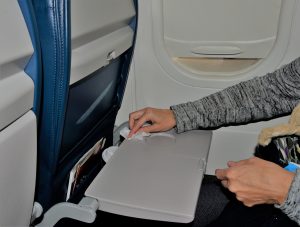 Before you fly, be sure to pack some anti-bacterial wipes in your carry-on. Airports and airplanes are high-traffic areas with many surfaces touched by numerous people. That makes them popular places for bacteria to reside.
Before you fly, be sure to pack some anti-bacterial wipes in your carry-on. Airports and airplanes are high-traffic areas with many surfaces touched by numerous people. That makes them popular places for bacteria to reside.
Upon finding your seat, wipe down all high-touch surfaces. This includes the armrests, seat belt buckle, video screen, and especially, the tray table.
While flying, avoid touching your face, nose, mouth, or rubbing your eyes. This is how viruses are transmitted from surfaces to yourself. Also, it’s a good idea to sanitize your area a second time prior to eating.
You may want to bring a few disposable place mats to use. They allow you to eat and drink from your tray table without worrying about what germs may still be present.
It’s good practice to refrain from placing your belongings in the seat back pockets. You never know what could be hiding in there, like the last passenger’s used tissues. You don’t want to risk getting cold germs all over your laptop or magazine and then carry them with you.
Sanitize Your Hands
In addition to anti-bacterial wipes, you should add hand sanitizer to your carry-on. Hand sanitizers containing at least 60% alcohol kill the bacteria and germs that may be on your hands and prevent them from being transferred to your face or mouth.
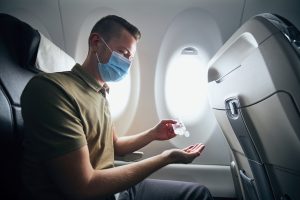 Therefore, sanitize your hands frequently, not just after using the bathroom. It’s particularly important to sanitize your hands prior to eating or drinking.
Therefore, sanitize your hands frequently, not just after using the bathroom. It’s particularly important to sanitize your hands prior to eating or drinking.
Wear a Mask
Wearing a mask when flying offers additional protection from viruses transmitted through the air. This includes the flu, common colds, RSV and COVID-19.
If you choose to wear a mask, be sure to keep it over your nose. Sanitize your hands before putting on, removing, or adjusting your mask. To put on or remove a mask, always use the ear loops to avoid contamination.
If mask adjustment is needed, do so by grabbing the front center of the mask rather than the edges closest to your face.
Circulate that Air
The total air volume on a large aircraft is typically replaced about 15-20 times an hour. The use of high-efficiency HEPA filters like those found in hospitals make the air cleaner than you might think. They remove 99.97% of airborne particles.
Once seated, be sure to turn on your air vent. Of course, use an anti-bacterial wipe to clean the vent handle/dial before using it.
Unfortunately, circulating the air around your seat may not be entirely beneficial if the person seated next to you is consistently coughing and sneezing.
Stay Hydrated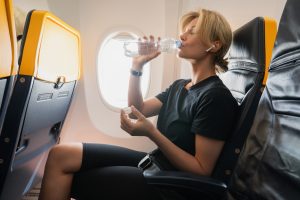
Flying is naturally dehydrating due to the cold, dry air, lower humidity levels and high altitude. Therefore, it’s important to drink plenty of water before and during your flight. Stick with water rather than coffee, caffeinated beverages or alcohol as they tend to accelerate dehydration and even cause you to feel bloated.
To sidestep purchasing an overpriced bottle of water while in the airport, consider packing an empty water bottle with you in your carry-on. Once you are through security you can fill the bottle with water prior to boarding the airplane.
As an additional preventative, bring a packet or two of Emergen-C, Airborne, or similar immune supporting drink mix with you and add to your bottled water. They are high in vitamin C and zinc which help to boost your immune system.
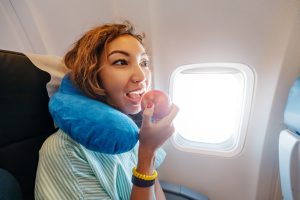 Eat Healthy, Stay Healthy
Eat Healthy, Stay Healthy
While waiting to board or sitting on the airplane, avoid snacking on overly processed or salty foods. These can cause bloating and contribute to further dehydration. Items high in sugar and fat will also deplete your energy.
As an alternative, pack healthy snack items like veggies, berries or nuts to help strengthen your immune system. Water-rich foods like cucumbers, oranges, and watermelon also help to naturally maintain hydration.
Keep Moving
To prevent stiffness and improve circulation, movement is important. And rather than trying to walk around the cabin, many activities can be done from your seat. This limits your exposure to all the other passengers on board.
Stretch out your back by simply bringing your chest down to meet your thighs. Do some neck rolls and shoulder raises, too. Foot pumps, ankle circles, and calf stretches help to keep the blood flowing. Try not to cross your legs as this restricts blood flow.
If possible, stand periodically and do a few calf raises. You might also want to bring a small massage ball or resistance bands to keep muscles engaged and reduce tension.
Upon arrival at your destination, resist the urge to go straight to bed. Instead, stick to the new time zone and do a little exercise. Yoga, walking, or a visit to the hotel gym is stimulating and refreshing.
Dress for Travel
The outfit you choose for flying should include layers. Airplanes tend to be cold. By dressing in layers, you can add and remove layers as needed. This is very helpful not only on the airplane but also as you adjust to different airports and even climates.
Another valuable tip for flying attire to consider is compression socks. Sound crazy? It’s not. These tight-fitting, knee-high stockings improve circulation which can reduce swelling in the legs and ankles during long periods of sitting. They can help reduce the risk of DVT (deep vein thrombosis), a condition that causes blood clots in the legs. They can even alleviate leg fatigue, making your legs feel more comfortable and less tired when you reach your destination.
Stay Moisturized
As we know, the air on a plane is unusually dry. Travel-sized moisturizing products such as hand lotion, lip balm and rewetting eye drops come in handy. Not only are they used for comfort, but they can aid in illness prevention since dry skin and lips can have small cracks, making them susceptible to germs.
Get Some Rest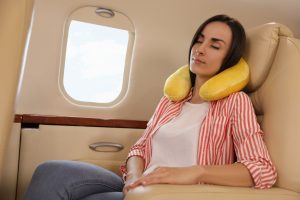
Sleep is vital for good health. It’s certainly easier said than done on an airplane, but earplugs or noise cancelling headphones, and an eye mask can help when on a long flight. And don’t forget a neck pillow!
A window seat is ideal since you have control over the window shade and the amount of sunlight coming in. It is also the optimal placement for avoiding seatmates climbing over you or people bumping into you in the aisle.
Private Charters
Of course, the most comfortable way to minimize your exposure to germs and viruses is by flying private. With a private charter, you travel exclusively with your own family, friends or coworkers. No other passengers are on board, and there’s plenty of room to move and relax while you fly.
If you are considering a private passenger charter, let us help. Grand Aire has over 35 years of experience in the air charter industry. Our Logistics Specialists are available 24/7/365 to evaluate your needs and provide you with the best aircraft charter options. Simply contact us at 1-800-70-GRAND or email our team directly at logistics@grandaire.com
